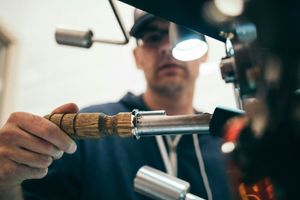My Biggest DIY Disaster and What It Taught Me: When Everything Goes Wrong

Transform Your Home Into a Smart Paradise - 2025 Guide
Discover the latest smart home technology that will revolutionize your daily routine.
I'm sitting now in our beautiful bathroom that we finally finished last year. It looks fantastic - white marble, glass doors, underfloor heating. No one would know that I nearly destroyed this room three years ago.
This is the story of my biggest DIY disaster. About how I thought I could handle everything myself and almost flooded our entire apartment. About how I spent $3,200 on damages I caused with my own hands.
But it's also a story about what it taught me. And why I think every DIY enthusiast should go through at least one proper disaster. Not for the damage, but for the humility.
How It All Started
It was winter 2022. Our bathroom looked like it was from the eighties - brown-yellow tiles, a shower enclosure with plastic doors that leaked, and a sink that was held up only by nostalgia.
Wife said: "We'll call professionals."
I said: "I can handle this myself. We'll save at least $20,000."
I was fresh off a successful living room renovation. Everything went well there, so I felt like a DIY genius. "A bathroom is just a bigger living room with water," I thought.
If only I knew how much that arrogance would cost me...
First Warning Signs (Which I Ignored)
Week 1: Demolition Without Reason
I started classically - demolition. I was tearing down tiles with the enthusiasm of a young barbarian. It was actually satisfying. Every broken piece was like a small victory over ugliness.
First mistake: I didn't photograph where the plumbing ran beforehand. "That's logical," I told myself. "Water will go where it was."
Second mistake: I didn't honestly check what was behind the tiles. I assumed there would be a normal wall. In reality, there was a drywall partition with insulation that was already attacked by mold.
Third mistake: I did the demolition on weekends. Neighbors weren't thrilled, but I thought: "They can handle one weekend."
They could.
Week 2: Plumbing Attempts
I had a clear plan: Move the sink one meter to the left. Simple, right? Just extend the piping.
Problem: I had no idea about slopes, pressures, or that old copper pipes can't simply be connected to new plastic ones.
What I did: I bought various adapters, fittings, and sealants. I struggled with it for an hour and finally it looked "pretty good."
Test: I turned on the water. No leak! I'm a genius!
Reality: It didn't leak for half an hour. Then it fell apart like a house of cards.
Week 3: Electrical Work (Where Real Disaster Begins)
I wanted to add more outlets for a hair dryer and shaver. I had already added an outlet in the living room once, so I "already knew how."
Difference: There's no moisture in the living room. In the bathroom there is.
What I didn't consider: IP ratings, protective circuits, distances from water, standardized wiring.
What I did: I ran an ordinary cable from the neighboring room, connected an ordinary outlet and "temporarily" covered it with a plastic bag.
I later found out I violated about eight safety standards at once.
D-Day: When Everything Falls Apart
It was Tuesday morning, February 14, 2023. Ironically on Valentine's Day. I had my last vacation day to finish "small details."
8:30 - First Warning
I turned on water to the new plumbing for the first time. For a moment it looked like everything was working. Then I noticed a small puddle under the sink.
"That's nothing," I told myself. "Just tighten the connection."
I tightened it. The puddle remained.
9:15 - Escalation
The puddle was growing. I started panicking and disassembling the connection. It turned out I had installed the gasket wrong and the pipe didn't actually fit together at all.
In panic, I started experimenting with different combinations of gaskets, glues, and silicone. I made myself an improvised sealing paste from silicone and Teflon.
It worked for 20 minutes.
10:00 - Catastrophe
The connection completely fell apart. Water started gushing in all directions. I ran to close the main shut-off valve in the basement.
Problem: I didn't know exactly where it was. It took me 10 minutes to find it.
During those 10 minutes an estimated 200 liters of water went through the bathroom.
10:30 - Domino Effect
Water found its way everywhere. It flowed through the floor into the apartment below. It got into the electrical installation I had "temporarily" fixed. Short circuit.
Power outage in the entire apartment. In January. With an infant at home.
Wife returned from work around eleven. She found me trying to shovel water out of the flooded bathroom.
Her first words: "I told you we should call professionals."
I said nothing. I couldn't.
Scope of Damage
Our Apartment
- Bathroom floor: Totally destroyed ($1,000 replacement)
- Electrical installation: Complete replacement necessary ($720)
- Hallway ceiling: Leakage, repair needed ($320)
- New plumbing work: Pro had to redo everything ($480)
Downstairs Apartment (Worst Part)
- Living room and bedroom flooding: $1,400 damage
- Painting: $200
- Destroyed furniture: $320
- Temporary accommodation: $280 (three days in hotel)
Total damage: $4,720
Insurance covered: $1,520
Out of our pocket: $3,200
Plus I still had to pay professionals to finish the bathroom: $3,600.
Worst Moments
Insurance Interview
Insurance sent an adjuster. An older man who had done the same job a hundred times. One look at my "installation" was enough for him.
"Sir, this is purely your fault. Violation of all standards, unprofessional work. We can only contribute symbolically."
I sat there like a schoolboy at the principal's office. $3,200 out of pocket. Money we had saved for a car.
Neighbors' Reaction
Worst was facing the neighbors. The lady from downstairs was crying when she saw her destroyed living room. She had photos from her grandmother there that can't be replaced.
I apologetically paid for everything. Even things insurance contributed to. I couldn't look into the eyes of a woman whose home I destroyed because of my arrogance.
Greatest Shame
I had to call my father-in-law to lend me money for completion. Father-in-law, to whom I had been telling for two years how handy I am.
During that phone call I felt like the biggest failure in the world. "I need to borrow $1,600 because I flooded the apartment."
What It Taught Me
Humility Before Craft
Biggest lesson: Being a DIY enthusiast doesn't mean knowing everything. Every craft has its nuances that are learned over years.
The difference between hobby DIY and profession is enormous. I can replace a faucet. A plumber can design an entire system to work for 20 years.
I stopped thinking I was a jack-of-all-trades. Now I distinguish between what I can handle myself and what I need a pro for.
When to Call a Professional
Definitely professionals:
- Electrical work in wet areas
- Changes in plumbing (not just part replacement)
- Structural changes (wall demolition)
- Gas installations
- Complex underfloor heating
I can do myself:
- Replacing faucets and toilet seats
- Painting and wallpapering
- Simple drywall
- Furniture and shelf assembly
Value of Time and Nerves
I calculated it later. If I had called professionals right away:
- Bathroom finished in a month: Instead of six months
- Cost $3,600: Instead of $6,800 (damages + completion)
- No stress: Instead of six months of marital crisis
I would have saved $3,200 and lots of nerves. Plus I wouldn't have created an unforgettable "Valentine's" day.
Planning vs. Improvisation
My old approach: "Somehow it will work out." New approach: Plan, reserves, consultation with pros beforehand.
Now when I do a project:
- I draw a detailed plan
- Discuss it with someone experienced
- Prepare 30% reserve for time and money
- Leave all problematic parts to professionals
How I Approach Projects Now
Boundaries of My Own Abilities
I learned to say "I can't do this." It's difficult, especially for us men. But it saves more problems than it costs.
My new rules:
- If I don't know how it works → professional
- If damage would be over $400 → professional
- If it concerns safety → professional
- If I'm in a hurry → professional
Consultation Before Starting
Now I always call a craftsman at least for consultation. I pay $60 for an hour of advice but save thousands on mistakes.
I also found a mentor - an older DIY enthusiast with 40 years of experience. I always call him when I have doubts.
Quality Tools vs. Improvisation
I understood that bad tools lead to bad results. I used to improvise with whatever was available. Now I'd rather borrow or buy a quality tool.
I don't tackle projects without proper equipment anymore. Quality level, measuring tape, wrenches - that's not luxury, that's basic equipment.
Life After Disaster
Relationship with Wife
The first month was hell. Wife wouldn't talk to me, was angry about everything - damages, stress, how I ignored her advice.
Gradually it improved. It helped that I apologized not only to her but also to neighbors. And that I admitted she was right.
Today we laugh about it. Wife calls it the "Valentine's Day flood" and when I plan a project, she asks with a smile: "This time we'll call professionals, right?"
Relationship to DIY
I didn't give up on DIY. But I changed my approach. I do things I know how to do. And things I don't know, I don't belittle or underestimate.
Actually now I do more DIY than before. Because I'm not afraid of projects when I know my limitations.
Financial Impact
$3,200 out of pocket was noticeable. We had to postpone vacation, the new car is running older.
But it taught me to save for reserves. Now we have a "potential disaster" piggy bank - $2,000 aside in case something goes wrong.
Stories of Other DIY Enthusiasts
Pepek's Welding
Neighbor Pepek wanted to fix his fence himself. He bought a stick welder for $160 and thought welding was simple.
Result: Burned grass, hole in neighbor's tarp boat, almost a fire. $600 damage.
Lesson: Welding looks simple on YouTube. In reality, it's a craft.
Mirek's Roof
Mirek wanted to fix roof tiles himself. "Just replace a few damaged tiles."
Problem: Walking on the roof, he stepped through more tiles and damaged the sheathing.
Result: Leaking during the first storm. $2,400 damage.
Lesson: Leave roofs to roofers.
Honza's Heating
Honza wanted to add a radiator to the living room. "Just connect it to the existing system."
What he didn't consider: Hydraulic balancing, boiler capacity, expansion tank.
Result: Entire system stopped working in January. $1,000 repair + hotel for a week.
We all thought we were handier than we were. And we all learned humility the hard way.
Advice for Beginning DIY Enthusiasts
Start Small
Don't jump into big projects. Start with replacing handles, painting a fence, assembling Ikea furniture.
Every small success teaches you something new. And small mistakes won't bankrupt you.
Find a Mentor
Best investment isn't in expensive tools, but in a relationship with someone experienced.
This could be: Older neighbor, retired craftsman, experienced friend. Buy them a beer for advice.
Have Reserves
Always plan +50% time and +30% costs over original estimate.
Murphy's law applies doubly to DIY. What can go wrong, will go wrong.
Learn to Say "I Don't Know"
Most important phrase of every DIY enthusiast: "I can't handle this myself."
It's not failure to call a professional. It's responsibility.
What the Disaster Gave Me
Better Relationship with Craftsmen
I used to look at craftsmen as "expensive but necessary evil."
Today I respect their expertise. I know how many years of experience it takes for something to look simple.
I pay them gladly and don't haggle over price. Quality work deserves quality money.
Smaller Ego, More Humility
The greatest gift of that disaster was humility. I stopped thinking I could handle everything myself.
Paradoxically it freed me. I don't have to be an expert at everything. I can focus on things I enjoy and can do.
Better Planning
I learned to read instructions, plan ahead, consult problems before they arise.
My projects now take longer but are higher quality and stress-free.
Different View of Money
$3,200 damage taught me the value of money. And especially the value of professional work.
Today I'd rather pay more for quality than save on quality and pay later.
Conclusion After Three Years
I'm glad I made that mistake three years ago. Not because of the damage, but because of what it taught me.
I'm still a DIY enthusiast, but better. More realistic. More humble.
My current projects are more successful because I know when to stop and ask for help.
And that bathroom? It's beautiful in the end. It cost more, took longer, but works perfectly. Because professionals finished it.
To every beginning DIY enthusiast I want to say: Make mistakes. But make them small. And learn from them.
And remember: The most important tool of every DIY enthusiast isn't a drill or grinder. It's humility before the craft.
Good luck with your projects. And remember - even the biggest disaster can be the beginning of something better! 🔧
Smart Home Upgrade Package 2025
Transform your home with the latest smart technology
Transform Your Home Into a Smart Paradise - 2025 Guide
Discover the latest smart home technology that will revolutionize your daily routine.

